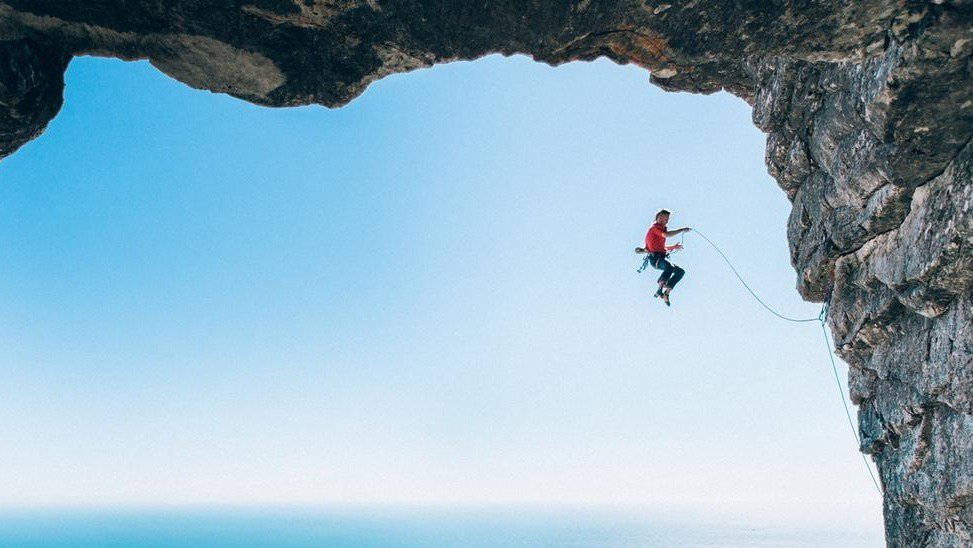Why does the idea of literally skiing off a cliff appeal to some people? Why do people willingly climb mountains with no safety gear? While many of us likely can’t relate to these experiences, we can relate to that feeling of adrenaline and passion that drives people to do this. As a research topic, I chose to study the epitome of this feeling - extreme sports - by tracing it from its earliest origins, its rise, and its relationship with competitions and sponsors, back to the psychology and phenomenology that fuels these incredible moments.
Extreme sports were never “invented,” yet there has been a notable boom in recent decades. But first, what defines extreme sports? Extreme sports are often termed “extreme” by their consequences, meaning that if something goes wrong the results can be catastrophic. Since the dawn of time, humans have pushed themselves to the limits and taken tremendous risks... and not always out of necessity. Archeologist and historian Daniel Brock reveals evidence that “Hawaiian Islanders hurtled headfirst down steep, snowless mountains on narrow, toboggan-like sleds at 50 miles an hour.” While this sport sadly didn’t become mainstream, others did. Extreme sports made their rise to popularity in the 1960s during the counterculture movement and have kept growing ever since, with various icons and events marking their rise. Action stars like Evel Knievel built upon this growth, giving the public an image of the untamed side of extreme sports with wild, daring stunts that went wrong more often than right.
Today, extreme sports have taken a prominent spotlight, as seen in countess movies like James Bond and popular video games like Skate 3 or Steep. Nike’s ‘Dream Big” ad even featured three extreme sport athletes, revealing the sports presence in mainstream society. However, if you paid attention you’ll notice that I just skipped something. How did a counterculture movement in the 60s marked by unique daredevils turn into something so prevalent today? That’s where competitions, monetization, and sponsors come in.
Competitions and increased public attention of extreme sports led to the sports rampant growth and commercialization. The introduction of ESPN’s extreme games in 1996, later known as X Games, was a milestone in the genres popularity. Janel Ginn writes in Extreme Sports, “with the creation of X Games, increased coverage from TV networks, and a gradual entrance into the olympic spotlight, the popularity of extreme sports among fans and participants soared.” The creation of a well known competition made the sport more tangible, in turn making it easier to understand. However, competitions did more than just make the sport more publicized: they also made marketing a factor. Author Holly Thorpe writes that “in the late 1990s, television and corporate sponsors recognized the huge potential in [extreme sports] to tap into a market.”And they did just that. Their marketing strategy goal was to make extreme sports synonymous with an EXTREME lifestyle, and that’s what was sold. The companies sell the belief that there’s always more you could be doing, always something cooler you could be doing to take it to the MAX - and that you need their product to do it.
As Josie Appleton puts it in her article Extreme Sports Hype is Commercialism, “the adrenaline factor is sold in concentrated form."
The same author even argues that in some cases the products “are a bigger business than the sports themselves,” with millions of dollars in ad revenue and product sales flowing in. Slogans from extreme sport sponsorslike Nike’s ‘Just Do It,’ Red Bull’s ‘Gives You Wings,’ and Monster’s ‘Unleash the Beast,’ all feed of this marketing strategy to sell an EXTREME lifestyle… and it’s worked. Individuals, sponsors, and even cereal brands want to associate themself with the sport.
Competitions like Red Bull Playstreets and the Dew Tour depict extreme sports and sponsor logos side by side on every inch of the course… and in the title. With people who have never stepped on a skateboard before wearing Thrasher or buying Nike SB, consumer’s drive to associate themselves with the extreme sports image has been clearly built up. While the list of similar dynamics of brands trying to get behind the extreme sports hype could go on and on, another aspect of the relationship between sponsors and athletes needs to be recognized: that is, the athletes’ and subcultures’ rejection of this partnership in some cases.
The individualistic, counterculture nature of extreme sports and mass media’s portrayal of the sport don't match, creating an interesting dynamic between the athletes, competitions and sponsors. According to professor Rinehart, the problem with ESPN and similar programs is that they decide how the sport is seen. From the camera angle to “the often times prewritten script,” entertainment networks and marketers control how viewers interact with the sport. For a sport that is built on freedom, creativity, and individualism in risk taking, this leaves little room for liberty.
Professor Messner writes that the marketing of “individualistic, even countercultural, athletes has created walking contradictions, where ‘rebel athletes’ look like… corporate billboards.”
Athletes and communities within specific extreme sports often times resent the role big corporations play in the sport. An example of this resentment is seen in Craig Kelly, a former world champion snowboarder who, as Holly Thorpe writes in the Berkshire Encyclopedia of Extreme Sports, “retired at the peak of his career from the competitive circuit that he likened to prostitution.” Kelly’s words speak for themself: “Society is full of rules, and I use the time I spend in the mountains as an opportunity to free myself of all constraints… the [rule bound, corporate driven] World Tour restricted the freedom that I found.” Countless skiers have trash talked FIS and sponsors, revealing a clear disconnect between the athletes and how they are used. Competitions and sponsors have created an interesting dynamic in extreme sports, but in the end this dynamic isn’t what defines the sports. The sport is defined by how the participant feels in those precious moments and what keeps them coming back. Delving back into the roots of the sport, why do people do it? What draws so many of us to extreme sports?
The psychology and phenomenology behind extreme sports attempts to explain what makes this genre of sports so captivating. To start, there is a misconception that “thrill seekers” are always reckless. Researcher’s studies of the sports participants reveal how much preparation actually goes into the athlete’s feats, with countless hours of practice aiming to perfect one’s abilities. World-class rock climber Alex Honnold describes his preparation for his unaided and unprotected summit of Yosemite’s El Capitan in the acclaimed new documentary “Free Solo,” going over his visualization of what every handhold and foothold of the climb will feel like among dozens of practice runs.

But there’s undoubtedly more at play in extreme sports than just preparation. In regards to the actual psychology, when extreme sport participants - or anyone for that matter - experiences something intense and climatic, nerve signals release a rush of dopamine, which in turn plays a huge role in happiness and feelings of optimism. Dopamine is highly desirable and addictive, so it keeps the athletes coming back. The interesting aspect of this is that people get desensitized to dopamine upon repeated exposure. In order to get the same ‘fix,’ athletes have to keep pushing themselves past their previous achievements. While psychology is one lens through which to analyze extreme sports, phenomenology does a more encompassing job of exposing the sport’s charm for its participants. Phenomenology focuses on consciousness and experiences through a first person view, allowing researchers to understand the feelings and emotions of the participants. According to researcher Robert Schweitzer, the co-author of Phenomenology and the Extreme Sport Experience, “[The phenomenological approach] allowed us to focus on the lived experience of extreme sports with the goal of explaining themes that are consistent with participants experience.” So what are these themes? One theme that was repeatedly brought up in extreme sport athletes testimonies was freedom. This freedom encompassed “freedom from constraints, freedom as letting go of the need for control, freedom as the release of fear, freedom as being at one, and freedom as choice and personal responsibility.” Another recurring theme among extreme sports participants was intensity of emotion. While summarizing their findings about these types of athletes following numerous interviews, Brymer and Schweitzer write “Death and fear appear to provide a channel to experience the immediacy of life in the moment, with an intensity many would consider at the risk of death.” This is something participants at any level can relate to, even without the risk of death aspect. Whether it’s dropping into a new jump line or swerving the right wall on a halfpipe, these raw, euphoric moments keep us coming back. While extreme sports can be studied and examined in countless research projects, there is something ineffable, indescribable within the experiences. The thrill, the euphoria, and in some cases the primitive, almost childish, desire to do something dangerous is hard to put into words. As mentioned earlier, researchers Robert Schweitzer and Eric Brymer listened to numerous testimonies of athletes discussing extreme sports, and their findings echo the indescribable nature of the sport:
Robert Schweitzer and Eric Brymer“without exception, those interviewed were clear that words were inadequate tools for exploring core elements of their experience. The only way to know the experience was to engage with the experience.”
In a way, ending an article on extreme sports discussing the participants experience of the sport is fitting. This is a sport that ultimately centers on the user, free from everything in those transcendent moments. From its recent rise and its complex relationship with marketing to the phenomenology of the actual experiences, extreme sports are fascinating. That thrill to push oneself and be entirely immersed in a single moment isn’t going anywhere… so neither are extreme sports.
Works Cited
Appleton, Josie. ‘Extreme Sports Hype Is Commercialism.’ Extreme Sports. Ed. Janel D. Ginn. Farmington Hills: Christine Nasso, 2008. 48-55. Print.
Brock, Daniel. ‘Archaeologist Works to Preserve Hawaiian Sledding.’ West Hawaii Today, April 20, 2008, www.westhawaiitoday.com/articles/2008/04/20/local/local05.txt.
Brymer, Eric and Robert Schweitzer. Phenomenology and the Extreme Sport Experience. New York: Routledge, 2017. Print.
Clemmitt, Marcia. “Extreme Sports.” CQ Researcher. CQ Press, 3 Apr. 2009, library.cqpress.com/cqresearcher/document.php?id=cqresrre2009040300.
Deb, Sopan. “A Look Back at Evel Knievel: A Daredevil Unafraid to Fail.” The New York Times. The New York Times Company, 29 June 2018, www.nytimes.com/2018/06/29/arts/ television/evel-knievel-travis-pastrana.html.
Isaksen, Joachim Vogt. “The Psychology of Extreme Sports: Addicts, Not Loonies.” Popular Science. HiNT, 22 May 2013, www.popularsocialscience.com/2012/11/05/the- psychology- of-extreme-sports-addicts-not-loonies/.
Rinehart, Rob. ‘Popularity of Extreme Sports May Be a Temporary Fad.’ Extreme Sports. Ed. Janel D. Ginn. Farmington Hills: Christine Nasso, 2008. 35-47. Print.
Smith, David Woodruff. “Phenomenology.” Stanford Encyclopedia of Philosophy. Stanford University, 16 Dec. 2013, plato.stanford.edu/entries/phenomenology/.
Thorpe, Holly. “Snowboarding.” Berkshire Encyclopedia of Extreme Sports. Ed. Douglas Booth. Great Barrington: Berkshire, 2007. 286-294. Print.


Comments